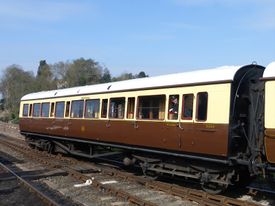GWR 9369 Nondescript Saloon
| GWRGreat Western Railway 9369 Nondescript Saloon | |
|---|---|
 GWRGreat Western Railway 9369 Nondescript Saloon | |
| Built By | GWRGreat Western Railway Swindon |
| Status | In service |
| Number | 9369 |
| Other numbers | DW150128 |
| History | |
| Built | 1923 |
| Designed By | CollettCharles Benjamin Collett, Chief Mechanical Engineer (CME) of the Great Western Railway 1922-1941 |
| Diagram | G56 |
| Lot | 1250 |
| Type | Nondescript, BTO |
| Length | 56ft 11¼in |
| Weight | 27t 11cwt |
| Seats | 40 unclassified (as built) |
| 1972 | Preserved on SVRSevern Valley Railway |
GWRGreat Western Railway Nondescript Saloon 9369 was ordered in 1915 as a successor to the 1912 ChurchwardGeorge Jackson Churchward, Chief Mechanical Engineer (CME) of the Great Western Railway 1902-1922 ‘toplight’ prototype 9055, but due to the First World War it was not delivered until 1923, by which time CB CollettCharles Benjamin Collett, Chief Mechanical Engineer (CME) of the Great Western Railway 1922-1941 had succeeded GJ ChurchwardGeorge Jackson Churchward, Chief Mechanical Engineer (CME) of the Great Western Railway 1902-1922 as CMEChief Mechanical Engineer. Like the prototype, 9369 was an unclassified or 'nondescript' saloon (ie not allocated to any specific class such as first or third) and was used for private hire, although unlike the prototype, it did not actually have toplight windows. It included a small brake compartment which allowed the carriage to be attached and detached at any station and to be parked,[1] although in service this was probably mainly used for storage of hampers rather than as accommodation for a guard. The two saloons and single compartment nominally seated 40 and two toilets were also provided. The internal layout is similar to the SVRSevern Valley Railway's third Nondescript Saloon 9103 where it is described in greater detail.
9369 spent most of its service life at Bristol. After withdrawal it saw departmental use as a Brake Third Open (BTO) numbered DW 150128, at Shrewsbury and Walsall, Norton Junction from where it arrived on 6 September 1972. It was originally purchased by a private owner, Mr John Tarrant, who oversaw a 10-year restoration. In autumn 1980, with internal restoration still not fully complete, 9369 was one of the two carriages used for filming The Good Soldier having received a coat of chocolate and cream and a couple of numbers.[2]
9369 is now owned by The Great Western (SVR) Association. It is normally seen in the Toplights set, but was moved into Kidderminster carriage works for a bogie overhaul in September 2016. It is finished in GWRGreat Western Railway 1934-42 livery featuring the ‘shirt-button’ roundel.
See also
References
- SVRSevern Valley Railway Stock Book, Ninth Edition
- Railway Heritage Register Carriage Survey
Links
| ||||||||||||||||||||||||||||||